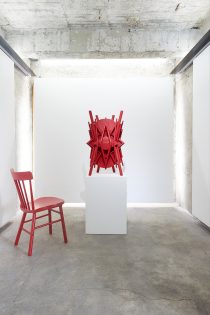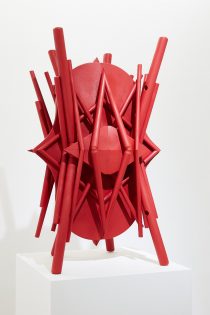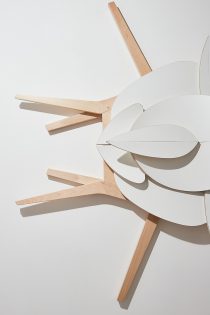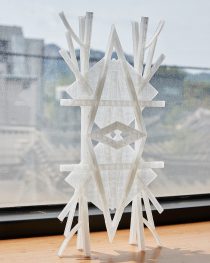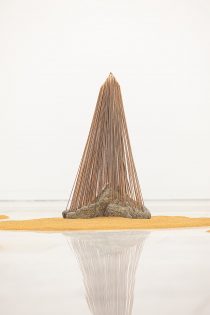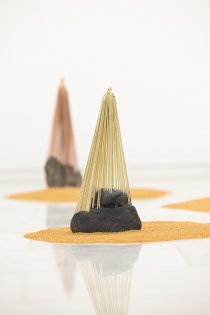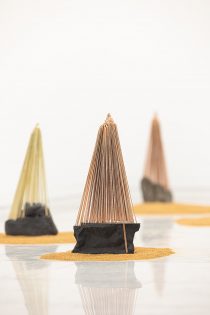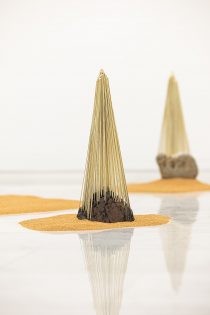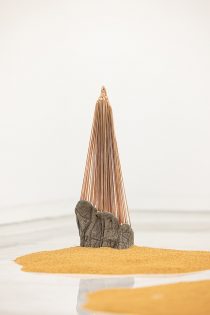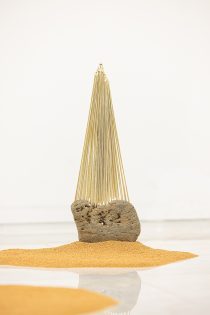평형갈등 _ 이가은, 2012
|
단체전 서문 _ Project 72-1 ‘평형갈등’의 관람자는 교실에 들어서는 순간, 먼저 여덟 구획으로 나뉜 강렬한 색면에 압도된 후, 교실 중앙에 있는 기이한 형태의 화분으로 시선을 옮긴다. 알로카시아가 자라고 있는 여덟 개의 화분은 서로 이어 붙여진 하나의 커다란 형상을 하고 있는데, 이는 공기정화기능을 가진 것으로 알려져 가정에서 흔히 볼 수 있는 식물 중 하나이다. 또한 칠판, 앞뒷문과 게시판 등을 통해 이 공간이 예전에 교실로 쓰였던 곳이라는 짐작이 가능한데, 작가는 교실이나 알로카시아와 같이 일상에서 흔히 마주치는 사물들을 가지고 작업을 해오고 있다. <평형갈등>은 작가의 근작, <중간으로 자라다>(2012)의 연장선 상에 있지만, 유기체를 사용했다는 점에서 이전과는 다른 새로운 시도로 보인다. 관람객들은 식물을 전시장에서 마주하면 이것이 유전자 조작된 것은 아닌지, 혹은 이렇게 자랄 수 있는지 같은 생물학적 질문을 작품에 던지게 된다. 만약 식물이 계속해서 자란다면, 이는 중력을 거슬러 태양을 향해 위로 구부러진 기이한 형태가 될 것이다. 또한 뒤집혀진 화분에서 흙이 쏟아지지 않는다는 점은 마치 그곳에만 중력이 작용하지 않는 듯한 묘한 풍경을 연출하는데, 이같이 작가는 친숙하던 사물이 어느 순간 매우 낯설게 느껴지는 경험을 유도한다. 많은 사람들이 그들의 유년시절의 대부분을 보내는 교실이라는 공간은 익숙함에서 느껴지는 낯설음을 표현하기에 더없이 적합한 소재였을 것이다. 이는 데리다(Jacques Derrida)가 말한 “부재하는 현존”을 상기시키는데, 데리다는 언어적 기호는 자의적 구성물로 그것의 의미는 영속적이지 않고 불안정하다고 말하며, 언어가 의미를 환기하는 동시에 은폐한다는 점을 강조한다. 작가도 외형이 당위성을 잃었다고 느낄 때, 즉 친숙했던 사물이 자의적 구성물로 인지되어 ‘모호함’과 이에 따라오는 불안과 두려움을 작가는 자신만의 논리적인 형태로 시각화하여 이를 ‘환원’ 및 극복하려 한다. 네 개의 색면이 만든 경계선이 화분의 절단선과 정확히 일치하는 ‘평형갈등’을 사진으로 먼저 보게 되면 이것이 포토샵의 기본적인 기능을 이용해 만든 디지털 이미지라는 추측이 가능하다. 먼저 현실에는 이와 같이 사방으로 뻗어 자라는 식물이 존재하지 않을뿐더러, 이것이 공중에 매달려 있기까지 하다는 점은 이 이미지가 가짜란 확신을 가능케 한다. ‘평형갈등’의 이미지를 본 관람자는 장 보드리야르가 말한 비물질성이 물질성을, 허구가 현실을 대신하는 “시뮬라크르가 지배하는 시대”를 떠올리게 될 것이다. 시뮬라크라는 진짜의 복제가 아닌, 그 스스로가 사실이 되는 하이퍼리얼의 세계를 가능케 하는데, 이 작품의 이미지를 본 후, 관람자가 ‘평형갈등’ 실재를 확인하게 된다면, 관람자는 가짜와 진짜의 구분이 불가능한 하이퍼리얼과 정면으로 마주하는 경험을 하게 된다. 이가은 (미술비평)
When the viewer step into the classroom, they will be overwhelmed by the eight different color field around them and then take a look at the strange looking pollen hanging in the middle of the classroom. Eight pots were cut and attached to each other as one, and Alocasia is planted at each of them. It is one of the plants that can be easily seen at home because of its air purification function. With the blackboard, front and back doors and bulletin boards, the viewer can easily guess the space was used for a classroom. As you can see, the artist Park Cheon-Wook has been using common things that can be encountered in everyday life. Equilibrium conflict is along the same line with the artist’s recent works Grow Into The Middle (2012), however it is the fresh attempt using an organism for the work. Likewise, the viewers will ask some of biological questions, such as whether it is a genetic manipulation plant, or it is actually able to be alive. Beside, the soil is not be spilled on the ground even though the pot is inverted, which makes it look like there is no gravity around. Also, if the plants keep growing, the upside down plants will be bent up towards the sunlight and create a bizarre form. Park said, sometime he has a moment that something familiar become totally unfamiliar, and the classroom that most people spend the considerable amount of time would be suitable to express these feelings. It reminds ‘the absence of presence’ Derrida argued. The linguistic sign is arbitrary constructs and its meaning is not persistent, rather instability, so Derrida talked about how language ventilates the meaning while concealing it. Likewise, when the appearance lose its justification, Park recognizes familiar objects are arbitrary constructs and feels ambiguity and uncertainty. Then the anxiety and fear comes with the uncertainty, and he tries to find the ways to defense and overcome these feelings with his own logical way to restore the form. If you see the image of Equilibrium conflict first, it is possible to think it is the image made with the basic features of Photoshop. The fields of colors which is segmented exactly into four and the cut lines of the pollen coincide with the borders of the color fields. In addition, the plants stretching in four directions are hanging in the middle which make it undoubtedly a digital image. It recalls the era dominated by simulacra Jean Baudrillard argued; the fiction takes place of the real, and non-materiality substitutes materiality. Also Simulacra is not a copy of the real, but become truth its own right; hyperreal. Therefore when we confront the truth behind the image, we are facing the hyperreal world, at which is not possible to classify the real and the unreal. Ga-eun Lee (Art Critic) |
